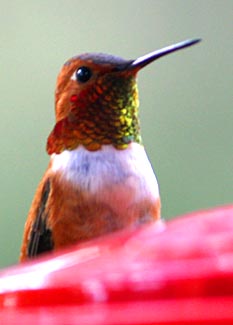|
| These highlights chronicle the year 2006. Created incrementally as
new photos were available, the year runs generally "backwards" on this
page.
The abbreviation "MTY" means "Monterey County" in the
text below. Text by Don Roberson. Photos on this page are copyrighted
by the photographers to whom they are attributed, and may not be
reproduced in any form (including other web sites) without the express
consent of the photographer. |
| On 31 May, a very late Pacific Golden-Plover was found and photographed
by Ryan Terrill & Mike Tyner (below right © Mike Tyner). It would
linger into early June (photo left © Oscar Johnson). Note the very
interesting upperpart pattern; this is apparently first-summer ("SY" in
banding lingo) plumage. There is only one other June record for MTY. |
|
|
|
| On 7 May, two interesting yard birds occurred. In the Rovell yard in
Marina, a rare spring White-winged Dove appeared and posed for photos
(below left © Steve Rovell). This proved to be the first documented
May record for the county. On that same date, in the Roberson/Carratello
yard in Pacific Grove, a White-throated Sparrow made a very late
appearance. There are only 3 prior May records of later date than this
one, and this particular White-throat was actually the 4th of its species
to visit this yard during this spring. It was seen off-and-on from 28 Apr-7
May (photo 4 May © D. Roberson). |
|
|
|
|
|
First, the continuing saga of Crested Caracara. On 10 April,
Bud Fox discovered the adult at the Odello field near the Carmel River
mouth. It is present through the date of these photos (16 Apr © D.
Roberson). This is a restricted access area in the revegetation project
but the bird can often be scoped from Hwy 1 or from Cross Hill. Since the
Santa Cruz caracara is still present, this is a different bird and almost
certainly the bird present near Pt. Sur in March (see more on that observation
below). The Caracara has been observed feeding in Odello field and is often
attacked by a territorial, dive-bombing White-tailed Kite! (above right).
Note that there is wing molt on the right wing (primary 6 is growing in,
and p5 may be as well) and it appear to be missing one rectrix. The Caracara
was seen off and on thereafter through 11 May, but was missed during Birdathon
weekend.
Also on 10 April, a hen-plumaged Painted Bunting
appeared at Tim Amaral's feeder in Prunedale. It, remained to 20 Apr (photos
below © Tim Amaral). The brightness of its plumage suggests this bunting
is either an adult female or a first-year male ("second-year male" in banding
lingo = born last summer). The sexes cannot be separated in these circumstances;
one of California's first records was a green bird singing on 24 June 1966
that proved to be a male when collected. Molt difference can sometimes
help; see Pyle, 1997, Identification Guide to North American Birds.
Note the pristine condition of the tail on this year's bird. Adult females
molt their tail in fall during their prebasic molt; first-year males molt
their tail in late autumn on the wintering grounds (at least if they are
of the western population of this species, as all California specimens
have been). Thus the tail could have been replaced as late as November-December
if this is a young male, and thus I lean toward "young male" as the more
likely age-sex choice because the tail looks fresh.
The California Bird Records Committee (CBRC) has
treated records of Painted Bunting conservatively. They have tended to
reject records away from the prime fall migration period (Sep-Nov), especially
birds in winter at feeders or near cities. They have been especially tough
on records of adult males which are often 'obvious' escapes from captivity.
Two April records of green birds have been rejected, but one had a bill
that was likely damaged in captivity and the other was near the Mexican
border. This species is common held in captivity in Mexico and is widely
available for sale in the Tijuana, Mexico, markets (Robb Hamilton, in litt.).
Yet, the CBRC did accept a 16 May 2001 record of a green bird on Pt. Loma,
so not everything is cut-and-dried. Local birders may remember a male Indigo
Bunting that frequented a feeder in April 2003 during its molt; that
species is also very rare in winter here but the April bird was accepted.
Given that parallel occurrence in another burning, and the pristine condition
of this Painted Bunting's plumage, it is my initial opinion that this is
likely a wild vagrant. I would anticipate others to have contrary opinions;
if so, I would welcome comments. The CBRC no longer reviews records of
this species (it was removed from the review list in 2005). Accordingly,
for the moment, this appears to represent the first spring record for MTY
and just the 9th county record overall. |
|
|
|
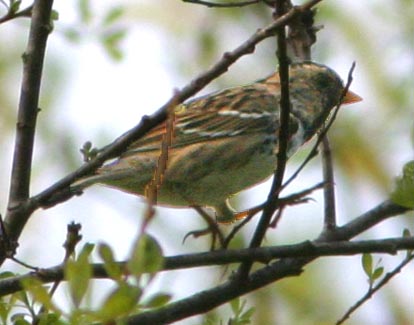 On
March 27, Brian Weed and his birding class had a first-winter Harris's
Sparrow at Laguna Grande Park, Seaside, near the upper (east) end of
the park. It was with a flock of Golden-crowned Sparrows that were eating
catkins on the newly-leafed willows (below). The Harris's was rather elusive,
but this photo (left) was obtained on 1 Apr during a Wild Bird Center
walk (© D. Roberson). On
March 27, Brian Weed and his birding class had a first-winter Harris's
Sparrow at Laguna Grande Park, Seaside, near the upper (east) end of
the park. It was with a flock of Golden-crowned Sparrows that were eating
catkins on the newly-leafed willows (below). The Harris's was rather elusive,
but this photo (left) was obtained on 1 Apr during a Wild Bird Center
walk (© D. Roberson).
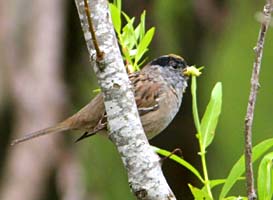
Rita and I tried again on 2 Apr, this time at mid-day, and this time
the Harris's was in the brushpile in the back of the cut-over area [it
looks like the City of Seaside is cleaning out the 'homeless encampment'
that has plagued this willow patch]. Further, the Harris's popped up and
gave a short burst of song, becoming the first reported songster of this
species in MTY since 1979. I snapped this photo (below) and am impressed
how rapidly the buffy face is turning grayer on a daily basis. |
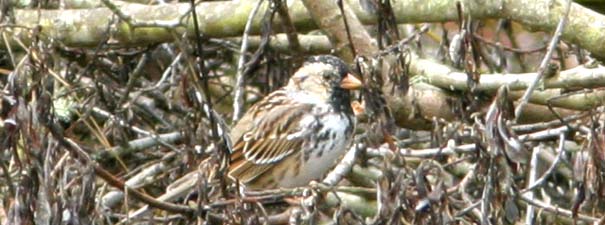
|
| On March 28, the Ventana Wildlife Society released the exciting news
that an active nest of California Condor had been discovered near
the Big Sur coast, the first condor nest in Monterey County in over a hundred
years! The mated pair are two of VWS's released and radio-tagged birds,
and the nest is a a hollow of a Coast Redwood. The exact location will
remain a secret for the protection of this pair — let us all hope they
hatch the first baby condors in MTY in over a century. Here's a photo of
the nest site © Joseph Brandt & Ventana Wildlife Society, graciously
forwarded by Kelly Sorenson, director of VWS. |

|

The condor nest was not the only BIG NEWS on the Big Sur coast on 28
March. Mike Tyner, an intern working for VWS at the Big Sur Ornithology
Lab, discovered an adult Crested Caracara in the fields at the base
of Pt. Sur at mid-day. It is actually in the photo of Pt. Sur (above) but
was also digiscoped (below left; © Mike Tyner) as it fed on a small
carcass (ground squirrel?). A heavy rain squall hit about 12:45 and the
caracara took flight and headed south. Remarkably, it was rediscovered
at 4:30 pm — in between rain showers — about a mile south, sitting on a
fence post on the El Sur Ranch (below right; © Don Roberson). Rita
Carratello was able to observe it in the same field of view as a Gray Whale
in the ocean beyond! The caracara was seen again on 29 March.
The bird was in rather good plumage and did
not have bands or jesses. It appears to be wild caracara. There was speculation
that it could be the adult that has been in Santa Cruz County since early
fall 2005, but the current information is that it was seen in Santa Cruz
before and after the Pt. Sur observation, so it seems unlikely to be the
same bird (fide D.L. Suddjian). |
|

| The hot story of mid-March was a Horned Puffin seen on several
dates between 17-23 Mar by skipper Richard Ternullo as he took out whale
watchers for Monterey Bay Whalewatch. The puffin was just off the Coast
Guard pier and breakwater, and initial glimpses were called the more expected
"Tufted Puffin," but then Richard confirmed its real identity on 22 March.
Several lucky birders scoped it at a distance there, or from the end of
Wharf #2, on 23 March, but a special boat trip in the early morning of
24 Mar did not bring success. During one bout of scoping on 27 Mar, these
Grampus,
sometimes called Risso's Dolphin (above), were seen in Monterey
harbor, just off the tip of the breakwater! There were at least a dozen
of these usually deep water cetaceans in the harbor (photo © D. Roberson;
you can easily spot the red-and-green buoy shown here in the harbor). So
it wasn't just deep-water puffins that were turning up in unexpected places! |
|
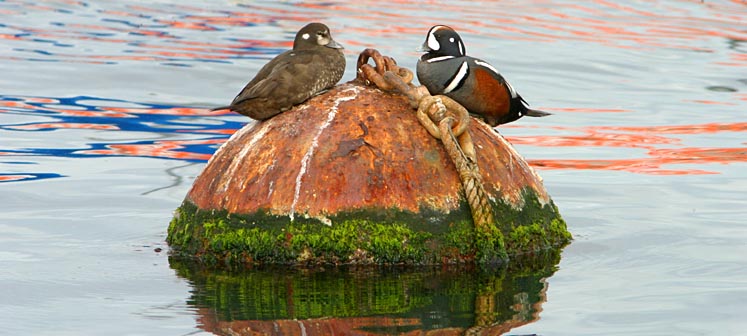
|
 The
year 2006 entered wet and rainy. Passing storms, interspersed with spells
of sun, would dominate through the first three months of the year. Other
than the lingering male Vermilion Flycatcher at Moss Landing [see
late
2005 highlights], there were not many rarities in Monterey County.
A pair of Harlequin Duck frequented Monterey harbor (above; photo
24 Mar), and a smattering of geese — of six species — were regularly reported
from Moss Landing to Monterey. Among the most engaging were two Brant
that fed daily into March on the grass at Lake El Estero, oblivious to
the joggers, walkers, and photographers (photo right, 17 Feb 2006; both
photos © D. Roberson). A Pileated Woodpecker at Carmel Highlands
31 Jan (Chris Hartzell) was about the sixth MTY record, but it was not
relocated. The
year 2006 entered wet and rainy. Passing storms, interspersed with spells
of sun, would dominate through the first three months of the year. Other
than the lingering male Vermilion Flycatcher at Moss Landing [see
late
2005 highlights], there were not many rarities in Monterey County.
A pair of Harlequin Duck frequented Monterey harbor (above; photo
24 Mar), and a smattering of geese — of six species — were regularly reported
from Moss Landing to Monterey. Among the most engaging were two Brant
that fed daily into March on the grass at Lake El Estero, oblivious to
the joggers, walkers, and photographers (photo right, 17 Feb 2006; both
photos © D. Roberson). A Pileated Woodpecker at Carmel Highlands
31 Jan (Chris Hartzell) was about the sixth MTY record, but it was not
relocated.
Since not a whole lot was happening elsewhere, we'll focus on events
in a single Pacific Grove yard (below). Just happens to be
my yard . . . ahem |
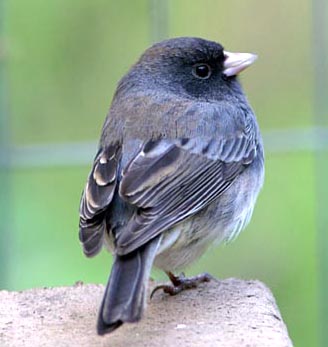 This
winter Rita Carratello & I played host to three different White-throated
Sparrows (above) and a "Slate-colored" Dark-eyed Junco
(left). The junco arrived 7 Oct 2005; I think it is a 90% "Slate-colored,"
probably a backcross between two intergrades — it looks like a typical
"Slate-colored" except for a slight brownish was to the back and lower
tertial. All three White-throats are youngsters. The first arrived 29 Oct;
the other two in December. Occasionally we see all three together. More
typically, birds #1 and #2 (above) feed next to each other, while #3 (right
above) is more shy. It has the vague spot in the center of its breast.
Although we have White-throats in migration almost annually, wintering
birds are quite rare. These three are with a wintering flock of about 25
Golden-crowned and 1 young White-crowned Sparrow. All remain present at
this writing (19 Mar 2006). This
winter Rita Carratello & I played host to three different White-throated
Sparrows (above) and a "Slate-colored" Dark-eyed Junco
(left). The junco arrived 7 Oct 2005; I think it is a 90% "Slate-colored,"
probably a backcross between two intergrades — it looks like a typical
"Slate-colored" except for a slight brownish was to the back and lower
tertial. All three White-throats are youngsters. The first arrived 29 Oct;
the other two in December. Occasionally we see all three together. More
typically, birds #1 and #2 (above) feed next to each other, while #3 (right
above) is more shy. It has the vague spot in the center of its breast.
Although we have White-throats in migration almost annually, wintering
birds are quite rare. These three are with a wintering flock of about 25
Golden-crowned and 1 young White-crowned Sparrow. All remain present at
this writing (19 Mar 2006).
Another interesting 'trio' appeared during migration on
10 March. Three separate Rufous Hummingbirds visited our single
hummingbird feeder: from L to R, below, a full-gorgeted male, a rufous-backed
male with a partial gorget, and a female (i.d. by ageing it as adult female,
and her green rump). We also had some Allen's in the yard at that time. |
White-throated Sparrows #1 & #2: 28
Jan 2006
White-throat #3 & Slate-colored Junco: 5 Feb 2006
partial gorget male Rufous 4 Mar 2006 [stayed a week]
full gorget male & female Rufous: 10 Mar 2006
all photos © Don Roberson
|
|
 On
March 27, Brian Weed and his birding class had a first-winter Harris's
Sparrow at Laguna Grande Park, Seaside, near the upper (east) end of
the park. It was with a flock of Golden-crowned Sparrows that were eating
catkins on the newly-leafed willows (below). The Harris's was rather elusive,
but this photo (left) was obtained on 1 Apr during a Wild Bird Center
walk (© D. Roberson).
On
March 27, Brian Weed and his birding class had a first-winter Harris's
Sparrow at Laguna Grande Park, Seaside, near the upper (east) end of
the park. It was with a flock of Golden-crowned Sparrows that were eating
catkins on the newly-leafed willows (below). The Harris's was rather elusive,
but this photo (left) was obtained on 1 Apr during a Wild Bird Center
walk (© D. Roberson).


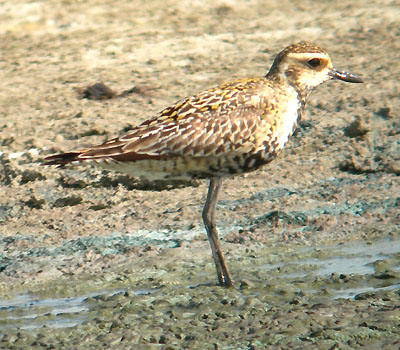

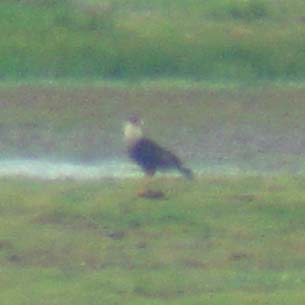
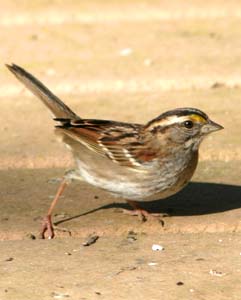
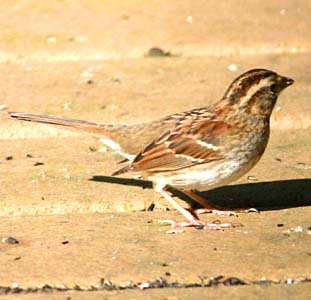
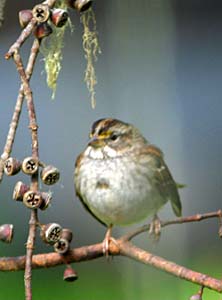
 This
winter Rita Carratello & I played host to three different White-throated
Sparrows (above) and a "Slate-colored" Dark-eyed Junco
(left). The junco arrived 7 Oct 2005; I think it is a 90% "Slate-colored,"
probably a backcross between two intergrades — it looks like a typical
"Slate-colored" except for a slight brownish was to the back and lower
tertial. All three White-throats are youngsters. The first arrived 29 Oct;
the other two in December. Occasionally we see all three together. More
typically, birds #1 and #2 (above) feed next to each other, while #3 (right
above) is more shy. It has the vague spot in the center of its breast.
Although we have White-throats in migration almost annually, wintering
birds are quite rare. These three are with a wintering flock of about 25
Golden-crowned and 1 young White-crowned Sparrow. All remain present at
this writing (19 Mar 2006).
This
winter Rita Carratello & I played host to three different White-throated
Sparrows (above) and a "Slate-colored" Dark-eyed Junco
(left). The junco arrived 7 Oct 2005; I think it is a 90% "Slate-colored,"
probably a backcross between two intergrades — it looks like a typical
"Slate-colored" except for a slight brownish was to the back and lower
tertial. All three White-throats are youngsters. The first arrived 29 Oct;
the other two in December. Occasionally we see all three together. More
typically, birds #1 and #2 (above) feed next to each other, while #3 (right
above) is more shy. It has the vague spot in the center of its breast.
Although we have White-throats in migration almost annually, wintering
birds are quite rare. These three are with a wintering flock of about 25
Golden-crowned and 1 young White-crowned Sparrow. All remain present at
this writing (19 Mar 2006).
